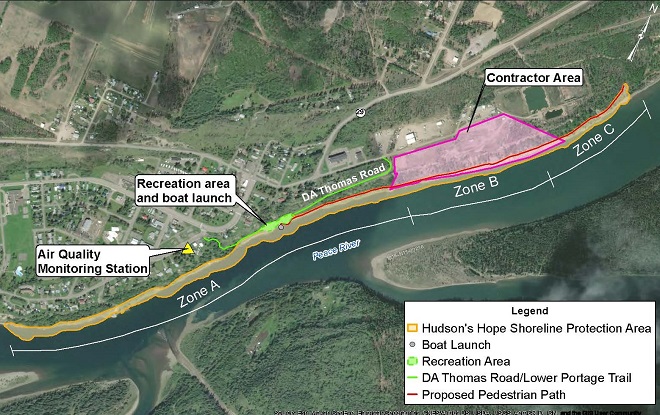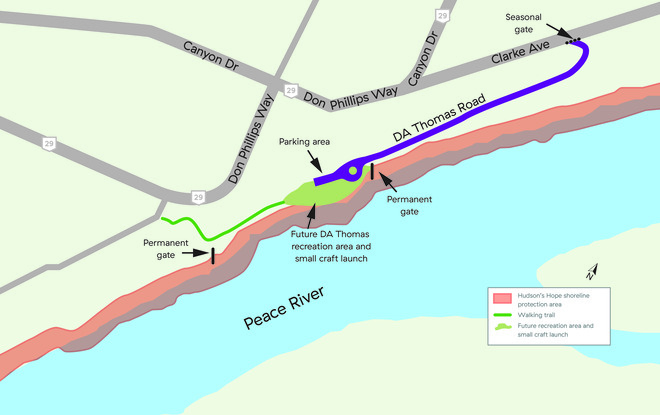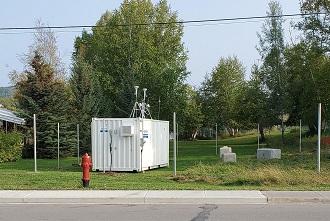Construction Activities
We're committed to providing Peace region residents, businesses, communities and Indigenous Nations with information about Site C construction activities in a timely manner.
Construction Activities Nav
We’ve built a 2.6-kilometre-long shoreline protection berm along the shore of Hudson's Hope.
The berm - a large barrier made of riprap, rocks, and gravel - will reinforce the shoreline and protect it from potential erosion once the Site C reservoir is filled.
The berm begins on the shoreline of the Peace River on the western end of the town, and extends downstream, past the municipal sewage treatment facility.
Construction of the berm was completed in November, 2022. 
The berm is currently closed to the public. The area of the berm southwest of the permanent gate will remain closed at the end of the project.
When it opens, residents are encouraged to wear appropriate footwear and use caution when accessing or walking on the berm.

Construction timeline
Early October, 2020
- The lower portion of Portage Trail and D. A. Thomas Road was closed and marked with signage for public safety. The trail and road will remain closed until the end of 2023.
- Crews mobilized to site, and brought materials and equipment to a laydown area within Zone B, as shown in the map above.
- Archaeological data recovery took place in several locations.
October - November, 2020
- Crews cleared vegetation and chipped or mulched debris.
- A temporary access road was built on the western end of the slope within Zone B, from Clark Avenue to the shoreline.
- Crews began hauling riprap (boulders and rocks) from Portage Mountain Quarry to the shoreline, using Canyon Drive and Clark Avenue.
November 2020 - 2022
- Crews placed riprap in the water and built the berm.
2023 - onwards
- The second phase of construction includes the construction of D. A. Thomas Road, the recreation area and small craft launch.
Berm cross-sections
Air quality monitoring

Air quality monitor on Dudley Drive: We installed an air quality monitoring station to provide real-time measurements on air quality, such as smoke, dust, and exhaust. Located on Dudley Drive near the shoreline and close to homes, the air quality measuring station operated during berm construction, and will continue through the first two years of Site C operations. This station is one of five that we have placed throughout the Peace Region. Air quality data is shared with the Ministry of Environment and Climate Change, and can be found on their website.
Mobile air quality monitors: Air quality monitoring is also taking place along the hauling route so we can better understand any effects that construction may be having. These results will be shared with the BC Environmental Assessment Office.
Air quality monitoring at worksite: We regularly complete air quality monitoring at the berm worksite to ensure that airborne dust levels are within WorkSafeBC regulations.
What to expect
Safety is our top priority and we are working with Site C contractors to ensure work is planned and managed effectively.
Construction areas will also be closed due to safety reasons. Fencing and signage will be installed.
Hours of work: Work usually takes place from 7 am to 7 pm, seven days a week. Work outside of these hours may be needed.
Traffic: Trucks will regularly move materials to the work site, via Canyon Drive. Other construction traffic will also increase.
Equipment: A variety of heavy equipment will be used. These include different types of on-and-off-road trucks, excavators, loaders, vegetation clearing machines, and graders. Rescue boats will be in the river for safety purposes.
Impacts: There will be increased noise, dust and traffic in the local area. Crews will mitigate these impacts when possible. These include:
- Monitoring air quality
- Applying water on work sites to reduce dust
- Using white noise back up beepers
- Installing noise barriers around generators
- Avoiding vehicle idling